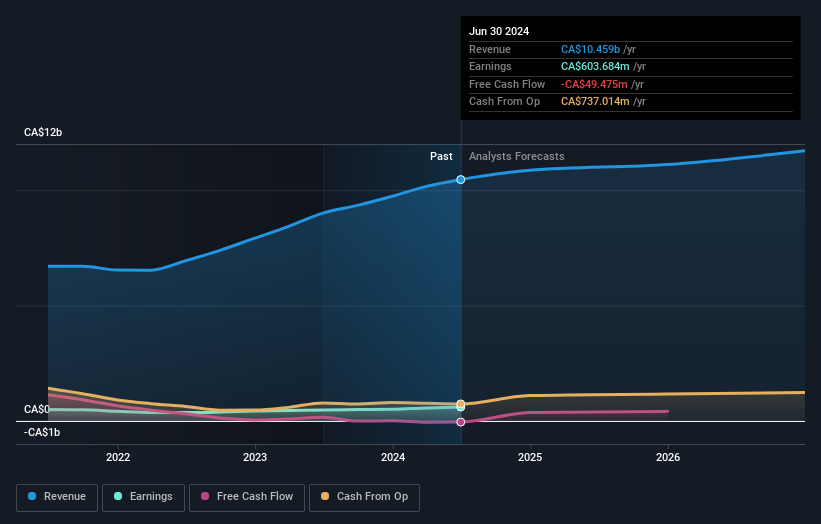- Canada
- /
- Auto Components
- /
- TSX:LNR
Retail investors invested in Linamar Corporation (TSE:LNR) copped the brunt of last week's CA$137m market cap decline

Key Insights
- The considerable ownership by retail investors in Linamar indicates that they collectively have a greater say in management and business strategy
- The top 17 shareholders own 50% of the company
- Insiders have been selling lately
Every investor in Linamar Corporation (TSE:LNR) should be aware of the most powerful shareholder groups. And the group that holds the biggest piece of the pie are retail investors with 43% ownership. In other words, the group stands to gain the most (or lose the most) from their investment into the company.
Following a 3.5% decrease in the stock price last week, retail investors suffered the most losses, but insiders who own 35% stock also took a hit.
Let's delve deeper into each type of owner of Linamar, beginning with the chart below.
See our latest analysis for Linamar

What Does The Institutional Ownership Tell Us About Linamar?
Institutional investors commonly compare their own returns to the returns of a commonly followed index. So they generally do consider buying larger companies that are included in the relevant benchmark index.
Linamar already has institutions on the share registry. Indeed, they own a respectable stake in the company. This implies the analysts working for those institutions have looked at the stock and they like it. But just like anyone else, they could be wrong. It is not uncommon to see a big share price drop if two large institutional investors try to sell out of a stock at the same time. So it is worth checking the past earnings trajectory of Linamar, (below). Of course, keep in mind that there are other factors to consider, too.

Linamar is not owned by hedge funds. Our data suggests that Linda Hasenfratz, who is also the company's Top Key Executive, holds the most number of shares at 33%. When an insider holds a sizeable amount of a company's stock, investors consider it as a positive sign because it suggests that insiders are willing to have their wealth tied up in the future of the company. For context, the second largest shareholder holds about 3.6% of the shares outstanding, followed by an ownership of 2.6% by the third-largest shareholder.
A closer look at our ownership figures suggests that the top 17 shareholders have a combined ownership of 50% implying that no single shareholder has a majority.
Researching institutional ownership is a good way to gauge and filter a stock's expected performance. The same can be achieved by studying analyst sentiments. There are a reasonable number of analysts covering the stock, so it might be useful to find out their aggregate view on the future.
Insider Ownership Of Linamar
While the precise definition of an insider can be subjective, almost everyone considers board members to be insiders. The company management answer to the board and the latter should represent the interests of shareholders. Notably, sometimes top-level managers are on the board themselves.
Most consider insider ownership a positive because it can indicate the board is well aligned with other shareholders. However, on some occasions too much power is concentrated within this group.
Our most recent data indicates that insiders own a reasonable proportion of Linamar Corporation. It is very interesting to see that insiders have a meaningful CA$1.3b stake in this CA$3.9b business. Most would be pleased to see the board is investing alongside them. You may wish to access this free chart showing recent trading by insiders.
General Public Ownership
The general public, who are usually individual investors, hold a 43% stake in Linamar. While this group can't necessarily call the shots, it can certainly have a real influence on how the company is run.
Next Steps:
I find it very interesting to look at who exactly owns a company. But to truly gain insight, we need to consider other information, too.
I like to dive deeper into how a company has performed in the past. You can find historic revenue and earnings in this detailed graph.
If you are like me, you may want to think about whether this company will grow or shrink. Luckily, you can check this free report showing analyst forecasts for its future.
NB: Figures in this article are calculated using data from the last twelve months, which refer to the 12-month period ending on the last date of the month the financial statement is dated. This may not be consistent with full year annual report figures.
New: AI Stock Screener & Alerts
Our new AI Stock Screener scans the market every day to uncover opportunities.
• Dividend Powerhouses (3%+ Yield)
• Undervalued Small Caps with Insider Buying
• High growth Tech and AI Companies
Or build your own from over 50 metrics.
Have feedback on this article? Concerned about the content? Get in touch with us directly. Alternatively, email editorial-team (at) simplywallst.com.
This article by Simply Wall St is general in nature. We provide commentary based on historical data and analyst forecasts only using an unbiased methodology and our articles are not intended to be financial advice. It does not constitute a recommendation to buy or sell any stock, and does not take account of your objectives, or your financial situation. We aim to bring you long-term focused analysis driven by fundamental data. Note that our analysis may not factor in the latest price-sensitive company announcements or qualitative material. Simply Wall St has no position in any stocks mentioned.
About TSX:LNR
Linamar
Produces engineered products in Canada, Europe, the Asia Pacific, and rest of North America.
Flawless balance sheet and undervalued.


